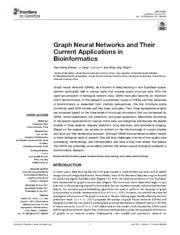A copy of this work was available on the public web and has been preserved in the Wayback Machine. The capture dates from 2021; you can also visit the original URL.
The file type is application/pdf.
Filters
Identification of miRNA-Small Molecule Associations by Continuous Feature Representation Using Auto-Encoders
2021
Pharmaceutics
Controlling miRNAs with small molecules is studied herein to provide new drug repurposing perspectives for miRNA-related diseases. ...
Experimental methods are time- and effort-consuming, so computational techniques have been applied, relying mostly on biological feature similarities and a network-based scheme to infer new miRNA–small ...
., (2015) [40] to predict SM-miRNA associations by integrating biological information from different sources. ...
doi:10.3390/pharmaceutics14010003
pmid:35056899
pmcid:PMC8780428
fatcat:5d7uwicddrhx3d4whjdzzzankq
DeepsmirUD: Precise prediction of regulatory effects on miRNA expression mediated by small molecular compounds using competing deep learning frameworks
[article]
2022
bioRxiv
pre-print
By further integrating miRNA-cancer relations, we established a database of potential drugs associated with cancers to aid in explaining the drug mechanisms of action in diseases and offering novel insight ...
Taken together, our method shows great promise to assist and accelerate the therapeutic development of potential miRNA targets and small molecule drugs. ...
FQ is supported by the National Natural Science Foundation of China (Grant No. 32000462) and the Scientific Research Funds of Huaqiao University (Grant No. 22BS114). ...
doi:10.1101/2022.06.30.498304
fatcat:tlhhd2kf65ezlowl7copm5hrom
BNEMDI: A Novel MicroRNA–Drug Interaction Prediction Model Based on Multi-Source Information With a Large-Scale Biological Network
2022
Frontiers in Genetics
Then, the inherent attributes of drugs and miRNAs are expressed as attribute features by MACCS fingerprints and k-mers. ...
To date, many researchers leveraged miRNA to reveal drug efficacy and pathogenesis at the molecular level. ...
For the purpose of mining the information from the chemical structure of biological entities, they regarded the miRNA sequences and drug SMILES sequences as sentences and implemented the word2vec algorithm ...
doi:10.3389/fgene.2022.919264
pmid:35910223
pmcid:PMC9334674
doaj:5ff43654bd1444d29593b1c3b1a1dc52
fatcat:kfpnlxkixjenlg4nmmq2l4yh4y
Artificial Intelligence in Drug Discovery: A Comprehensive Review of Data-driven and Machine Learning Approaches
2020
Biotechnology and Bioprocess Engineering
, and drug repositioning. ...
Generally, AI is applied to fields with sufficient data such as computer vision and natural language processing, but there are many efforts to revolutionize the existing drug discovery process by applying ...
Acknowledgments This work was supported by the National Research Foundation of Korea (NRF) grant funded by the Korea government (NRF-2020R1A2C2004628), and was supported by the Bio-Synergy Research Project ...
doi:10.1007/s12257-020-0049-y
pmid:33437151
pmcid:PMC7790479
fatcat:wqdmkkas2nb65gy3pymlgisuwi
Integrative Construction and Analysis of Molecular Association Network in Human Cells by fusing Node Attribute and Behavior Information
2019
Molecular Therapy: Nucleic Acids
Specifically, we constructed a large-scale MAN composed of 1,023 miRNAs, 1,649 proteins, 769 long non-coding RNAs (lncRNAs), 1,025 drugs, and 2,062 diseases. ...
Then, each biomolecule in MAN can be represented as a vector by its attribute learned by k-mer, etc. and its behavior learned by node2vec. ...
Cheng et al. 15 infer new targets for known drugs only through drug-target bipartite network topology similarity. ...
doi:10.1016/j.omtn.2019.10.046
pmid:31923739
pmcid:PMC6951835
fatcat:nmweqhhtkvddnhpluv6hhjnnbe
Learning representations of molecules to predict intermolecular interactions by constructing a large-scale heterogeneous molecular association network
2020
iScience
To this end, a heterogeneous molecular association network is formed by systematically integrating comprehensive associations between miRNAs, lncRNAs, circRNAs, mRNAs, proteins, drugs, microbes, and complex ...
This work provides systematic landscape and machine learning method to model and infer complex associations between various biological components. ...
First, the molecular association network is constructed by integrating 18 types of associations, 14,315 nodes, 114,150 molecular associations between mRNA, lncRNA, protein, miRNA, circRNA, drug, disease ...
doi:10.1016/j.isci.2020.101261
pmid:32580123
pmcid:PMC7317230
fatcat:4vpw2ykwyvdrjknq7w5zjuzyhq
MeSHHeading2vec: A new method for representing MeSH headings as feature vectors based on graph embedding algorithm
[article]
2019
bioRxiv
pre-print
Thus, it can act as input and continue to play a significant role in any disease-, drug-, microbe- and etc.-related computational models. ...
information to enhance the distinguishable ability of vectors. ...
Funding This research was funded by the National Natural Science Foundation of China, grant number 61772333, 61902342.
Conflict of Interest: The authors declare no conflict of interest. ...
doi:10.1101/835637
fatcat:w6wgdb4brjaspme3gv6vmfkhta
MeSHHeading2vec: a new method for representing MeSH headings as vectors based on graph embedding algorithm
2020
Briefings in Bioinformatics
The results show that the MeSH headings characterized by graph embedding algorithms can not only be treated as an independent carrier for representation, but also can be utilized as additional information ...
Thus, it can serve as an input and continue to play a significant role in any computational models related to disease, drug, microbe, etc. ...
The drug SMILES was downloaded from DrugBank and transformed into fingerprints by python package called RDKit [30] . ...
doi:10.1093/bib/bbaa037
pmid:32232320
pmcid:PMC7986599
fatcat:ni5bdg6hmbfohj6nzsgvm2vsie
Biomolecule and Bioentity Interaction Databases in Systems Biology: A Comprehensive Review
2021
Biomolecules
Nevertheless, as the number of such sets increases, it is becoming more and more difficult for an end user to know what the scope and focus of each repository is and how redundant the information between ...
To cope with this data flood, computational approaches, web services, and databases have been implemented to deal with issues such as data integration, visualization, exploration, organization, scalability ...
MiRNA sequences were collected from miRBase and disease-associated miRNAs from the Human microRNA Disease Database (HMDD) [138] . ...
doi:10.3390/biom11081245
pmid:34439912
pmcid:PMC8391349
fatcat:32aums2jtbc5vdcdknzfczajsy
A review of computational drug repositioning: strategies, approaches, opportunities, challenges, and directions
2020
Journal of Cheminformatics
Drug repositioning, therefore, plays an important role in optimizing the pre-clinical process of developing novel drugs by saving time and cost compared to the traditional de novo drug discovery processes ...
Drug repositioning is the process of identifying novel therapeutic potentials for existing drugs and discovering therapies for untreated diseases. ...
[19] established a database (Pharmaco-miR) to identify miRNA-gene-drug triplet set associations by combining data on miRNA targeting and protein-drug interactions. ...
doi:10.1186/s13321-020-00450-7
pmid:33431024
pmcid:PMC7374666
fatcat:yymhfsis4vgibo4surxzcrvp5m
Bioentity2vec: Attribute- and behavior-driven representation for predicting multi-type relationships between bioentities
2020
GigaScience
Based on this, we propose Bioentity2vec, a new method for representing bioentities, which integrates information about the attributes and behaviors of a bioentity. ...
Results We constructed a molecular association network, which contains 18 edges (relationships) between 8 nodes (bioentities). ...
Wang et al. adopted the logistic model tree methodology to integrate information from multiple sources to discover unknown associations between diseases and microRNA (miRNA) [12] . ...
doi:10.1093/gigascience/giaa032
pmid:32533701
pmcid:PMC7293023
fatcat:cmo2fvzoujg6ffsvyzth4eghw4
Graph Neural Networks and Their Current Applications in Bioinformatics
2021
Frontiers in Genetics
Then, three representative tasks are proposed based on the three levels of structural information that can be learned by GNNs: node classification, link prediction, and graph generation. ...
Meanwhile, according to the specific applications for various omics data, we categorize and discuss the related studies in three aspects: disease prediction, drug discovery, and biomedical imaging. ...
FUNDING This research was funded by the National Natural Science Foundation of China (No. 61862067) and the Doctor Science Foundation of Yunnan Normal University (No. 01000205020503090). ...
doi:10.3389/fgene.2021.690049
pmid:34394185
pmcid:PMC8360394
fatcat:4p55ap6sivcy7h6dpne5fut6lu
Biomarker2vec: Attribute- and Behavior-driven Representation for Multi-type Relationship Prediction between Various Biomarkers
[article]
2019
bioRxiv
pre-print
Biomarker2vec is an algorithm that represents the nodes as vectors by integrating biomarker attribute and behavior. ...
In addition, a drug-disease association prediction case study was performed to validate our method's ability on a specific object. ...
Wang et al. carry out the Logistic Model Tree to discover unknown miRNA-disease associations by integrating multi-source information [9] . ...
doi:10.1101/849760
fatcat:7fqvdz7y3zbqzcttml2fpjck4e
Drug-Disease Association Prediction Based on Neighborhood Information Aggregation in Neural Networks
2019
IEEE Access
It is based on neighborhood information aggregation in neural networks which combines the similarity of diseases and drugs, the associations between the drugs and diseases. ...
To better evaluate our approach, we also performed data analysis based on one-to-one association's prediction and robust analysis by testing on different datasets. ...
By integrating information about drug or disease features with known drug-disease associations, the comprehensive similarity measures are initially developed to calculate the similarity between drugs and ...
doi:10.1109/access.2019.2907522
fatcat:3i5mo3gjkrbzvflcedsqkov7le
Therapeutics Data Commons: Machine Learning Datasets and Tasks for Drug Discovery and Development
[article]
2021
arXiv
pre-print
All resources are integrated and accessible via an open Python library. ...
To date, TDC includes 66 AI-ready datasets spread across 22 learning tasks and spanning the discovery and development of safe and effective medicines. ...
It contains , MTI pairs with , miRNAs and , targets. We use miRBase (Kozomara et al. ) to obtain miRNA mature sequence as the feature representation for miRNAs. ...
arXiv:2102.09548v2
fatcat:i5f5vrbaxnehhmhqiuwkkx2s6y
« Previous
Showing results 1 — 15 out of 140 results














